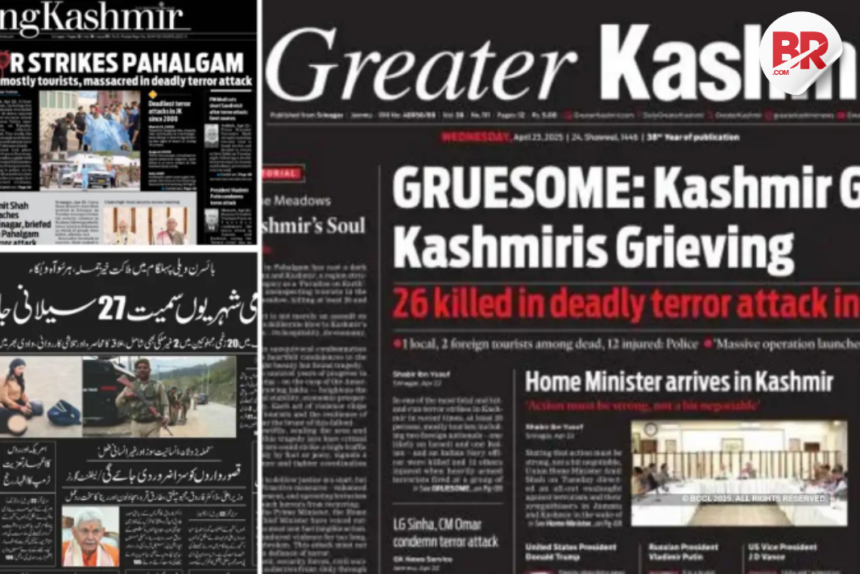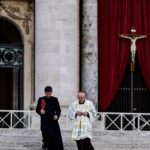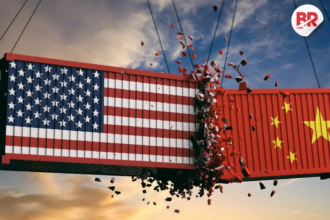
Kashmir Newspapers Black Protest: Grief in Black and White
28 people are dead.
A tourist meadow, once echoing with laughter, now silenced by gunfire. The response? Not just outrage. Not just mourning. But a blackout in ink.
On Monday morning, Kashmiris woke up to a haunting sight. The front pages of leading dailies — Greater Kashmir, Rising Kashmir, Kashmir Uzma, Aftab, and Taameel Irshad — were entirely black, save for stark white and red headlines. This Kashmir newspapers black protest was more than symbolic. It was a unified, ink-drenched cry for justice — and survival.

“Kashmir Gutted, Kashmiris Grieving”
The headline from Greater Kashmir read like a eulogy.
“Gruesome: Kashmir Gutted, Kashmiris Grieving”
Below it, the facts: 26 killed in what was one of the deadliest terror attacks in the valley in recent years. (Updated toll: 28)
The editorial pulled no punches.
“The massacre in the meadow – Protect Kashmir’s soul”
It wasn’t just an attack on lives — it was an attack on Kashmir’s identity, its hospitality, and the lifeblood of its tourism economy.
What does this mean for the average person?
For the tourist who booked a summer retreat in Pahalgam, it means second-guessing.
For the shikara-wallah who sells saffron-scented dreams on Dal Lake, it means empty boats.
For locals? A gut-wrenching déjà vu. Again.
The location — Baisaran meadows, known for their postcard views — was specifically chosen. Not for strategic impact, but for symbolic terror. This was tourism season. The message from the attackers was clear: “Your peace isn’t safe here.”
Also Read A Grandfather’s Heartbreak: Naval Officer Killed in Pahalgam Terror Attack
Who was behind the massacre?
The Resistance Front (TRF), a shadow group linked to Lashkar-e-Taiba, claimed responsibility. These aren’t new names in Kashmir’s long, tragic glossary of violence — but the patterns are shifting.
They aren’t just hitting military or political targets. They’re targeting Kashmir’s future — its economy, its reputation, and its people’s hope.
The government’s response
Prime Minister Narendra Modi immediately called a high-level Cabinet Committee on Security (CCS) meeting.
Home Minister Amit Shah made a swift visit to the site, assuring that perpetrators will face “iron-handed justice.”
But the people want more than promises.
As the editorial urged:
“The government, security forces, and citizens must stand united — not just to fight terrorism, but to protect Kashmir’s soul.”
Silent protests speak loudest
A black page. No images. No ads. Just grief.
This Kashmir newspapers black protest was journalism doing what it’s rarely allowed to do in conflict zones: grieve publicly, and demand collective conscience.
It was also a quiet reminder that Kashmir’s media, often caught between censorship and conflict, still finds ways to roar.
And let’s be honest — when ink runs dry, the message is often loudest.
What now?
Grief is not governance. But it is a start.
These black pages were not just mourning the dead. They were calling for the living to wake up.
For every local whose livelihood depends on a peaceful Kashmir.
For every policymaker whose job it is to keep it that way.
And for every Indian who’s tired of seeing Kashmir as a headline, not a home.
Because here’s the irony: Kashmir’s most powerful protest wasn’t a riot, a speech, or a strike.
It was silence — printed in black.
Also Read Pahalgam Terror Attack: “They Will Not Be Spared,” Vows Modi After Emergency Return












